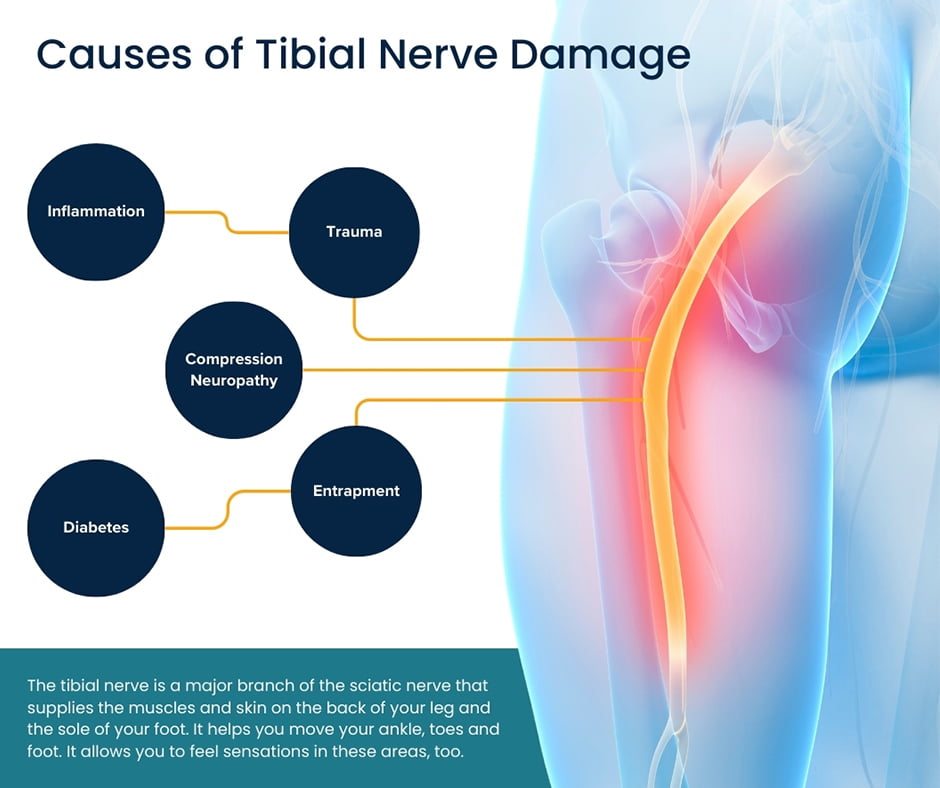Walking, running or even just getting up from sitting can become excruciating if you suffer from a disease or injury that involves your tibial nerve. A tibial nerve runs down each of your legs and is responsible for much of the feeling and function in your lower legs. To get an accurate diagnosis and appropriate tibia nerve damage treatment, call the experts at Pain Management NYC for a consultation. They’ll create a tibial nerve entrapment treatment plan and minimally invasive tibia nerve pain treatment so you can avoid further complications.
What Is the Tibial Nerve?
The tibial nerve is a major branch of the sciatic nerve that supplies the muscles and skin on the back of your leg and the sole of your foot. It helps you move your ankle, toes and foot. It allows you to feel sensations in these areas, too. The tibial nerve can be injured by trauma, compression or inflammation, causing pain, numbness, tingling, weakness or loss of function in the affected leg and foot. This damage affects your mobility and balance.
Pain Management NYC is a top-rated pain relief center in New York City. At Pain Management NYC, board-certified doctors have access to state-of-the-art facilities to develop personalized treatment plans for effective tibial nerve pain treatment.
Pain Management NYC doctors have the solution you need, including:
- Nerve blocks
- Injections
- Spinal cord stimulation
- Regenerative therapy
- Minimally invasive surgery
What Are the Common Causes of Tibial Nerve Damage?
The tibial nerve can be damaged by various factors that affect its structure or function. Trauma is one of the top causes of damage to this nerve. Injuries to the leg, such as fractures, dislocations or wounds, can damage the tibial nerve or its branches. The nerve can also be compressed by swelling, bleeding or scar tissue that develops around an injury site.
Another common cause of this damage is compression neuropathy. The tibial nerve can be squeezed or pinched by tight or ill-fitting shoes, casts or braces. It can also be compressed by tumors, cysts or abscesses in the leg or foot.
Other common causes include:
- Entrapment. The tibial nerve can get trapped or irritated by certain anatomical structures, such as the tarsal tunnel, a narrow passage in the ankle that the nerve passes through. This condition is called tarsal tunnel syndrome and can cause pain, numbness and tingling in the foot.
- Inflammation. The tibial nerve can be inflamed by infections, autoimmune diseases or allergic reactions. Inflammation causes nerve damage by reducing blood flow, oxygen and nutrients to the nerve.
- Diabetes. Diabetes mellitus is a chronic condition that affects the metabolism of sugar in the body. High blood sugar levels can damage the blood vessels and nerves, including the tibial nerve. This can cause diabetic neuropathy, a condition that affects the sensation and function of the feet.

What Are the Symptoms of Tibial Nerve Damage?
Tibial nerve damage affects the sensation and function of your leg, foot and toes. Depending on the severity and location of the nerve injury, you may experience different symptoms. You may feel sharp, shooting, burning or throbbing pain in the back of your leg, heel or sole of your foot. The pain may worsen with movement or pressure.
You may also develop numbness or lose some or all the feeling in the bottom or side of your foot, or in your toes. You may also have difficulty sensing temperature, touch or vibration.
Other symptoms include:
- Tingling. This feels like pins and needles, electric shocks or crawling sensations in your foot or toes.
- Weakness. You may have trouble moving your ankle, foot or toes. You may also have difficulty standing on your toes, pointing your toes or turning your foot inward.
- Muscle atrophy. You may notice that the muscles in your calf, ankle or foot become smaller or softer over time due to lack of use.
- Foot drop. You may have difficulty lifting your foot or toes up, causing your foot to drag or slap on the ground when you walk.
What Are the Long-Term Complications of Untreated Tibial Nerve Damage?
Tibial nerve damage has serious and lasting consequences if left untreated. The most common complication is chronic pain. You may suffer from persistent and severe pain in your leg and foot that doesn’t respond to conventional painkillers. Chronic pain then affects your mood, sleep and quality of life.
There’s also the danger of foot deformity. You may develop abnormal foot posture or shape, such as flat feet, claw toes or hammer toes. Foot deformity can make it difficult to wear shoes, walk or balance.
Other serious long-term effects include:
- Foot ulcers, which are open sores or wounds on the bottom or side of your foot, especially if you have diabetes or poor blood circulation. Foot ulcers can become infected and lead to gangrene or amputation.
- Muscle weakness and atrophy. Once you lose muscle strength and mass in your legs and foot, it becomes hard to move or exercise. Muscle weakness and atrophy then increases your risk of falls, injuries and fractures.
- Nerve damage in other areas of your body, such as your hands, arms or face if the underlying cause of your tibial nerve damage isn’t treated properly.
What Tibial Nerve Entrapment Treatment Options Are Available?
Tibial nerve damage treatment depends on the cause, severity and location of the nerve injury. The first option is medications. Over-the-counter and prescription pain relievers, anti-inflammatory drugs and nerve pain medications reduce your discomfort and inflammation.
Another option is physical therapy that provides you with an array of services like exercises, stretches, massage and electrical stimulation to improve your nerve function, muscle strength and range of motion.
Other tibial nerve damage treatment includes:
- Nerve blocks or injections of local anesthetics, steroids or other substances to block or reduce the pain signals from the nerve
- Nerve stimulation, including for your spinal cord , to deliver pain-relieving electrical pulses in the problem nerve
- Surgery, which is an option usually used reserved for tibial nerve entrapment treatment that involves repair, graft or transfer of the nerve to release the nerve from compression or entrapment
Without the appropriate tibial nerve pain treatment, the condition can become debilitating with long-term effects on leg and foot function, sensation and appearance. If left untreated, it can lead to chronic pain, foot ulcers, infection or amputation. That’s why you need to seek professional help from nerve disorder specialists.
Pain Management NYC is the foremost pain relief center in New York City. They have highly qualified and experienced doctors, and the most advanced and innovative tibial nerve damage treatment. They diagnose and treat your tibial nerve injury with the best possible outcomes. Contact Pain Management NYC today and take the first step towards a pain-free and healthy future.

Leon Reyfman, MD, is a top-rated, best-in-class interventional pain management doctor. He is a nationally recognized pain relief specialist and is among the top pain care doctors in New York City and the country. He is an award-winning expert and contributor to prominent media outlets.
Dr. Leon Reyfman has been recognized for his thoughtful, thorough, modern approach to treating chronic pain. He has been named a “top pain management doctor in New York” and one of “America’s Top Doctors™” for advanced sports injury treatments. Among other accolades, he was voted by peers as a “Castle Connolly Top Doctors™” and “New York Super Doctors™”. Dr. Leon Reyfman was a part of the medical team at the 2016 Summer Olympic Games in Rio de Janeiro, Brazil.
